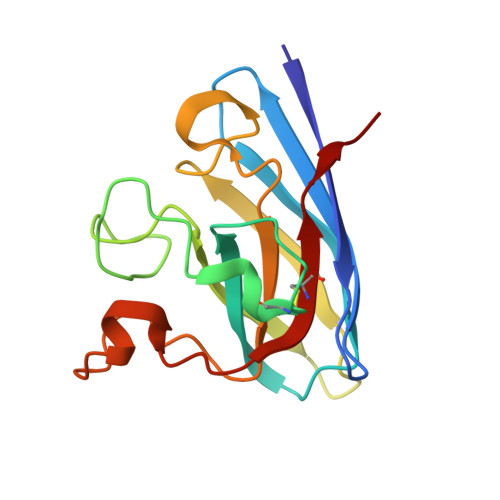Intrinsic structural vulnerability in the hydrophobic core induces species-specific aggregation of canine SOD1 with degenerative myelopathy-linked E40K mutation.
Hashimoto, K., Watanabe, S., Akutsu, M., Muraki, N., Kamishina, H., Furukawa, Y., Yamanaka, K.(2023) J Biological Chem 299: 104798-104798
- PubMed: 37156398
- DOI: https://doi.org/10.1016/j.jbc.2023.104798
- Primary Citation of Related Structures:
7WWT, 7WWY, 7WX0, 7WX1 - PubMed Abstract:
Canine degenerative myelopathy (DM), a fatal neurodegenerative disease in dogs, shares clinical and genetic features with amyotrophic lateral sclerosis, a human motor neuron disease. Mutations in the SOD1 gene encoding Cu/Zn superoxide dismutase (SOD1) cause canine DM and a subset of inherited human amyotrophic lateral sclerosis. The most frequent DM causative mutation is homozygous E40K mutation, which induces the aggregation of canine SOD1 but not of human SOD1. However, the mechanism through which canine E40K mutation induces species-specific aggregation of SOD1 remains unknown. By screening human/canine chimeric SOD1s, we identified that the humanized mutation of the 117th residue (M117L), encoded by exon 4, significantly reduced aggregation propensity of canine SOD1 E40K . Conversely, introducing a mutation of leucine 117 to methionine, a residue homologous to canine, promoted E40K-dependent aggregation in human SOD1. M117L mutation improved protein stability and reduced cytotoxicity of canine SOD1 E40K . Furthermore, crystal structural analysis of canine SOD1 proteins revealed that M117L increased the packing within the hydrophobic core of the β-barrel structure, contributing to the increased protein stability. Our findings indicate that the structural vulnerability derived intrinsically from Met 117 in the hydrophobic core of the β-barrel structure induces E40K-dependent species-specific aggregation in canine SOD1.
- Department of Neuroscience and Pathobiology, Research Institute of Environmental Medicine, Nagoya University, Nagoya, Aichi, Japan; Department of Neuroscience and Pathobiology, Nagoya University Graduate School of Medicine, Nagoya, Aichi, Japan.
Organizational Affiliation:


















